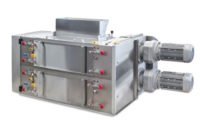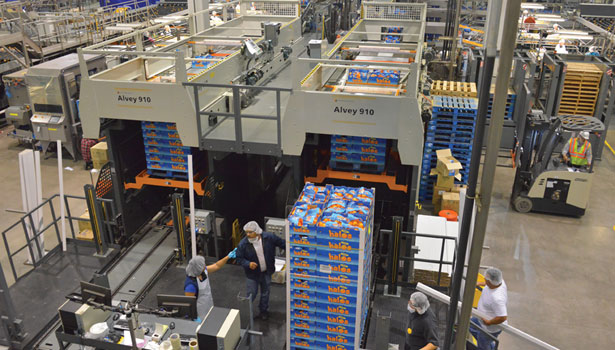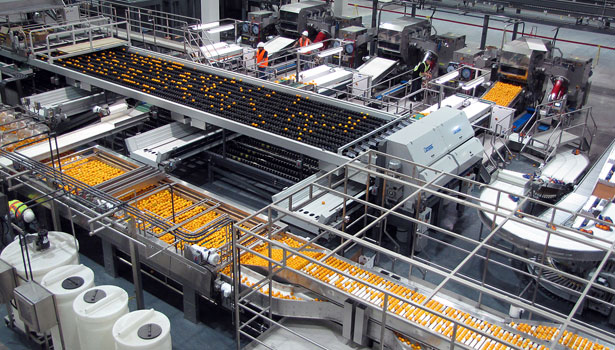Fabulous Food Plants
Automation keeps fruit fresh at Paramount Citrus
This 640,000-sq.-ft. citrus fruit processing/packaging facility is almost completely automated and has a roof of solar cells and a fuel cell system to supply energy to the plant and the grid.

Alvey 910 palletizers get the Halos clementines ready to go to shipping. Source: Paramount Citrus Packing Company.

Most of the roof at Paramount’s new plant contains solar cells that produce 2.7 MW of power per year. Source: Paramount Citrus Packing Company.

Natural gas-driven fuel cells from Bloom Energy create 1.6 MW without combustion. Source: Paramount Citrus Packing Company.

This pre-grading line is the first step in sorting, which is followed by a final grading line. Source: Paramount Citrus Packing Company.

Both the pre-grade and packaging lines provide washing, drying and waxing of Halos clementines. Source: Paramount Citrus Packing Company.

Packaging line 1 of 5 grades and sorts the fruit before packaging into bags. Source: Paramount Citrus Packing Company.






Click here to view video footage of Paramount Citrus |
Click here to view more images of Paramount Citrus |
The end of a busy workday. It’s late fall and the yellows, oranges and reds are fading from the trees as they shed their leaves, and are replaced by a golden sunset. Time to relax and have a colorful, tasteful seasonal treat before a late dinner: California clementines with a glass of sherry and some slices of the cheese of your choice.
Chances are the clementines you purchased came from Paramount Citrus Packing Company in Delano, CA. This golden-orange fruit is ready to harvest near the end of October, and the harvest is now so big that it takes a brand-new, automated washing, grading, inspection and packing plant to handle the sheer number of fruit. The benefit of this automated plant is that it provides consumers really fresh fruit consistent in size, color, quality and taste. In addition, the plant scores environmental points.
Situated on 34 acres next to an existing Paramount plant that packs oranges and lemons, Paramount’s new plant was built to handle 7,500 clementine-producing acres in California’s Central Valley, and will accommodate an additional 6,000 acres, which are expected to begin producing fruit in the next few years. The 640,000-sq.-ft. facility is the largest citrus packing facility in the world and cost $200 million to build. When the yearly clementine production is finished, the facility can also be pressed into service to process and package lemons. Not only does the facility package fruit, it also makes electricity to offset the power requirements to run the machinery, and when the machinery is not in operation, it feeds electricity back into the grid all year long.
Paramount Citrus Packing Company is owned by Roll Global, which acted as the general contractor to the new packaging facility. Roll Global, headquartered in Los Angeles, is a privately held company run by the husband-and-wife team of Stewart and Lynda Resnick. Other familiar brands owned by Roll Global include Paramount Farms (grower and processor of Wonderful Brand almonds and pistachios), POM Wonderful (fresh pomegranates and juice), Fiji Water, Justin Wine and Teleflora. Roll Global believes strongly in education and has donated millions of dollars to fund education through scholarships, school construction and ongoing education support.
Handling the harvest
In 2011, Paramount and its partners packed and shipped 60 million boxes of clementines. In 2012, shipments totaled around 90 million boxes, and shipments are expected to reach 140 million boxes in the next few years as the new trees bear fruit. Known as Cuties last year, the fruit’s name has been changed to Halos beginning this year. According to Eric Johnson, Roll Global vice president of capital projects, Paramount supplies about 51 percent of the clementines sold in stores. Halos represent 60 percent of the domestic production of all clementines. The facility packs 85 percent of all Halos and Fowler Packaging packs the other 15 percent.
The new facility has the capacity to process 4,000 bins of fruit daily to fill 800,000 three-pound bags (or 625,000 five-pound bags) each day. The plant can also accommodate 31 million pounds of clementines in cold storage rooms.
Construction considerations
Paramount chose Younglove Construction Company, based in Sioux City, IA as the A&E/C firm of record to supervise construction of the production/packaging facility. Teter Architects & Engineers was chosen as the designer. Site work began in November 2010, and the construction was completed in time for the fall harvest in October 2012. To speed the construction, the structure was built using precast concrete for the walls, roofs, beams and columns, which not only provided simpler construction, but contributed to food safety as well. The 2,100 precast elements used in the building are made of self-compacting concrete (SCC).
SCC consolidates when placed and does not require any additional consolidation efforts such as vibration. Constructors can place SCC at a faster rate with an improved, more uniform architectural surface and little or no remedial surface work. SCC is useful for filling restricted sections, heavily reinforced sections and hard-to-reach areas, creating structural and architectural shapes and surface finishes, which are not easily achievable with conventional concrete. The use of SCC for precise concrete elements results in a sanitary facility that is more easily maintained than other food plant construction methods, according to Johnson.
Specially designed, precast concrete hybrid moment frames were installed where the equipment or door openings didn’t allow for the use of shear walls. The architects and engineers placed the slab-on-grade using microfibers to minimize hairline cracking and a color additive for a more uniform floor color. The slab-on-grade’s surface was treated with Ashford Formula to harden/dustproof the surface and create a sheen that gets better as it ages. There is no surface film or coating to peel, blister or require replacement.
Special Cazaly hangers were used to support the precast concrete double-T roof members on the precise concrete beams, resulting in a sanitary installation with minimal dust ledges to eliminate the unsightly edges of supporting beams. Although this style of hanger has been around since the 1950s, many modifications to its original design have been created to increase its strength and minimize the potential of corrosion.
Due to thermal expansion and seismic design requirements (the San Andreas Fault is 50 miles away), separation joints were installed, resulting in a total of eight independent structures. Typical average temperatures range from the mid-40s in the winter to the mid-80s in the summer. Separation joints were determined by Teter’s lead engineers with the input of one of the nation’s leading designers of precast concrete buildings, says Johnson.
Various factors were considered in the placement and size of the separation joints. While the temperature differential for the area is not unusual, the sheer size of the building made shrinkage and expansion from temperature a larger factor than normal. This led to a need for expansion joints, which were strategically placed at the ridge line and along the main interior wall to maximize floor space. Once the joints were placed, their sizes were dictated by the lateral drift of the building based on earthquakes and wind loads. Because of the extreme distance between the walls, the building was designed to sway potentially up to five inches during a large earthquake. To avoid the various sections of the building from colliding with each other, they are separated based on the calculated drift.
The office is a steel-framed, two-story structure with steel moment frames to accommodate the large, open rooms and many widows Paramount wanted. In all, the construction of the new facility used 57,500 cubic yards of concrete (enough to cover a football field playing area 32 feet deep). Over 400 miles of pre-stressed concrete steel strands and 3,900 tons of reinforcing steel were used in the concrete.
With all the equipment in constant motion and a large amount of forklift traffic, the architects designed in a safety feature to keep employees out of danger. An elevated perimeter walkway/stair system allows employees to get to their work areas safely by minimizing their exposure to forklifts. Most employees first come into the facility through the two-story office area and enter the plant on the elevated walkway. “We want the employees to be able to access their workstations without crossing any forklift paths,” says Johnson.
Energy savings/creation
With the huge footprint the structure creates in the California sun, it made sense to use most of the roof for a photo-voltaic (PV) solar array to trim some of the energy costs to run the processing/packaging equipment. The finished roof contains a Solyndra 2.7 MW cylindrical reflective solar array, one of the largest, privately owned rooftop solar installations in the US.
Supplementing the PV solar array system is a 1.0 MW fuel cell system manufactured by Bloom Energy. The fuel cells use hydrogen from a natural gas input, which then produces electrical energy through a chemical reaction. There is no combustion in the process, so no NOX or SOX is emitted. In addition, CO2 emissions are 60 percent less than power generation through standard combustion.
The combination of the fuel cells and solar power generates more than 40 percent of the power used in the plant, which has a 10 MW connected load. Plus, the solar cells and fuel cells continue to generate power every day—all year long—energy that is sold back to the grid, says Johnson.
Other sustainable design features include LED lighting under the truck receiving canopies, parking lots and truck staging areas. Inside the building, high-bay 350W metal halide lighting is provided by ceramic pulse-start fixtures that contain motion detectors, reducing power consumption by 40 percent during times of low building activity. Due to the high ceilings, fluorescent lighting was ruled out as it doesn’t provide enough foot-candles at the floor level for proper food safety and sanitation activities.
While a soap and water cleanup is required at the end of each day, a chlorine-based sanitizer is used on all fruit contact surfaces every 24 hours. However, the facility itself generates very little waste water. Any waste fruit is sold as cattle feed, and although the rinse water cannot be reused due to food safety regulations, the volume used for fruit processing is small compared to the volume of fruit processed, says Johnson.
Because the facility is operational primarily in the winter and spring seasons, the facility needs no air conditioning or heating. However, process applications requiring heat include the fruit dryers and degreening room boilers; small boilers are used to heat wash water, and ammonia refrigeration is used for the cold storage warehouse and degreening process. Airflow throughout the processing/packaging area was designed to provide the cleanest air in packaging, which is then vented back into the pre-grading operation.
The entire automation system for process cooling and heating was designed by Ross and Sons, a system integrator and contractor. For the refrigeration systems, Ross and Sons chose M&M Refrigeration, a refrigeration system controls supplier. M&M installed Dunham-Bush/Hartford ammonia screw compressors, which were chosen for their reliability and efficiency, operational safety, trouble-free operation and easy maintenance. The clementines finished-product refrigeration system has three 200hp Dunham-Bush/Hartford screw compressors in the southwest mechanical room. The degreening room refrigeration system has two 500hp and one 300hp screw compressors located in the northwest mechanical room.
The plant is conveniently located on California Highway 99, one of three major north-south routes in California. In addition, fruit travels by rail, departing from a rail spur located just a mile away.
Handling the fruit
After the fruit has been harvested in the field, it is unloaded from tractor trailers under covered truck canopies and staged into degreening rooms. The plant has 42 of these rooms, each with a capacity for 513 bins. Each bin contains 1,000 pounds of fruit. The plant also has four cold-storage rooms with a capacity of 1,600 bins each. The degreening rooms have the capability to heat and cool the fruit.
In the early season, fruit arrives at the plant with a mostly “green” outside color. While the fruit is fully developed inside, the customer’s perception is the skin needs to be orange, or the fruit is not ripe. Degreening is a process where the fruit is warmed to 84°F and conditioned with an inert gas (ethylene), which changes the color of the rind from green to orange. The fruit is then cooled to 51°F. The entire process requires three days to complete. Unlike ripening rooms (for bananas), the degreening process does not affect the fruit’s interior properties or its natural brix and acid levels.
The next step is the pre-grading line, where the fruit is sorted into common size and grade categories; a vision system and load cells sort by size, weight, color and blemishes. The pre-grading line consists of:
• An Ag Design bin-dumping and handling system
• JBT brush beds and fruit dryers
• A Compac electronic grading line
• Fruit Handling Systems bin fillers.
Situated in a floor space of 235 x 560 ft., the Compac line is 310 ft. long, which makes it the longest known electronic grading line in the world. Able to process 10 million clementines daily, the line has 40 lanes and is expandable up to 70 lanes. According to Johnson, the plant will be expanded in 2014.
The system uses a series of high-speed cameras that measure the size, color and grade of the fruit (surface defects) as it continuously rotates on the conveyor; load cells sort the fruit to the proper weight. Once each piece of fruit’s size and grade have been determined, the system tracks it as it is conveyed down the lane and directed to one of 46 possible collection points. (The system is capable of 46 different combinations of size, grade and color. The fruit is broken down into nine possible sizes, three possible grades and three possible colors.)
If the fruit doesn’t make the pre-grade but the interior quality is acceptable, it is sorted into juice fruit. If not, the fruit is sold as cattle feed. After passing pre-sort, the fruit is placed into bins and stored in refrigerated work-in-progress (WIP) rooms for 12 to 36 hours. Then it goes through another round of Compac sorting as a double check for size.
The packaging lines also contain bin handling, brush beds and electronic grading—but on a smaller scale. The grading lines route fruit to one of three Giro baggers that pack the clementines into three- or five-pound bags at the rate of 50 bags per minute. Each bag machine is capable of running both three- and five-pound bags, but the entire packaging line can only run one size bag at a time.
Once filled, the bags are hand packed into trays and cases formed by IPak equipment. Other than truck loading and unloading, this is one of the few manual operations performed; Paramount is looking at the feasibility of automating it. The finished cases are palletized by Alvey palletizers and wrapped by a Muller stretch wrapper. The plant contains five pack lines with enough space (total area of 370 x 450 ft.) to add three more packaging lines.
The mix between three- and five-pound bags is approximately 50/50, according to Tim Hutcheson, Roll Global director, capital projects. Some volume-filled cartons (loose filled) are produced, but many of them are repackaged into bags at distribution centers. A container with four small trays nested in a larger tray typically has one five-pound bag in each smaller tray for a total of 20 pounds in the complete package. The larger cartons can contain between six and 10 bags of either five or three pounds in weight, respectively, placed inside the carton by hand. The typical equivalent carton weight for the fruit is 30 pounds. All current packaging for the clementines is either cardboard fiber carton or RPC (reusable plastic container).
The finished pallets are stored in flow-through racks in a 66,000-sq.-ft. cold-storage area prior to shipping. The shipping area has 17 dock positions, which are provided with advanced dock levelers and safety equipment.
But the story doesn’t end with shipping. While citrus fruit recalls are virtually unheard of, traceability is still a very important part of this process. The automated system offers full traceability down to the pack size level. The bag machine prints the product code on each bag, which is assigned to the barcode printed on the tray. The barcode is transmitted to the palletizer, which creates a pallet tag showing the history of every tray on the pallet. Significant procedures are in place if a recall is necessary. “Paramount Citrus conducts several mock recalls each year for Primus and AIB auditors, but we are not aware of any actual recalls occurring in the citrus industry,” says Johnson.
Paramount has achieved a superior food safety rating from both Primus Labs and AIB. At the farm, the company has adopted good agricultural practices (GAP); it has programs in place in the plant for continuous improvement, lean manufacturing, GMP and HACCP. With a food safety officer on its staff, the producer also has set up a pandemic strategy to be ready for any possibility.
Today, Paramount Citrus operates the Halos plant with approximately 500 employees. The plant is operational typically from November through April, coinciding with the annual clementines harvest. During peak season, the plant operates up to 20 hours a day, six days a week.
Ample office, personnel space
The facility also contains a 40,000-sq.-ft. main office, which functions as the world headquarters for Paramount Citrus. The front office includes a restaurant that serves made-to-order meals for all the plant employees. The office complex includes up to eight separate rooms for training and beginning/end-of-shift meetings.
In addition to locker room and rest room facilities, a medical clinic with three exam rooms is included in the front office to provide employees and their families with onsite medical care.
For more information:
Bill Bradbury, Younglove Construction Company, 712-233-3208,
bbradbury@younglovellc.com
See more Fabulous Food Plants
Looking for a reprint of this article?
From high-res PDFs to custom plaques, order your copy today!















